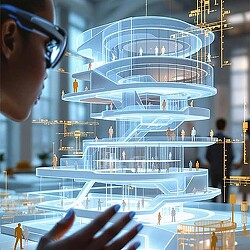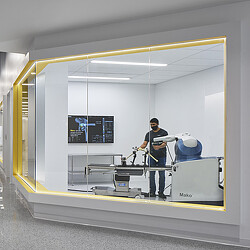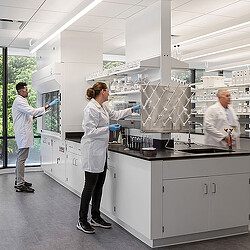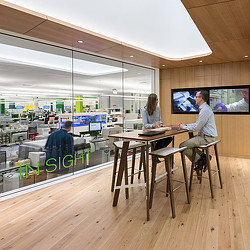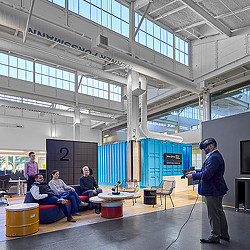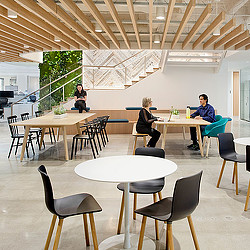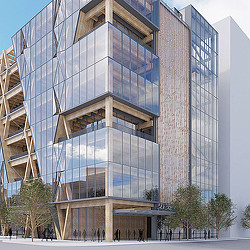How AI and Emerging Technologies Will Transform the Future of Labs
From AI and machine learning to quantum computing, we explore how technological advancements are redefining how scientists work.
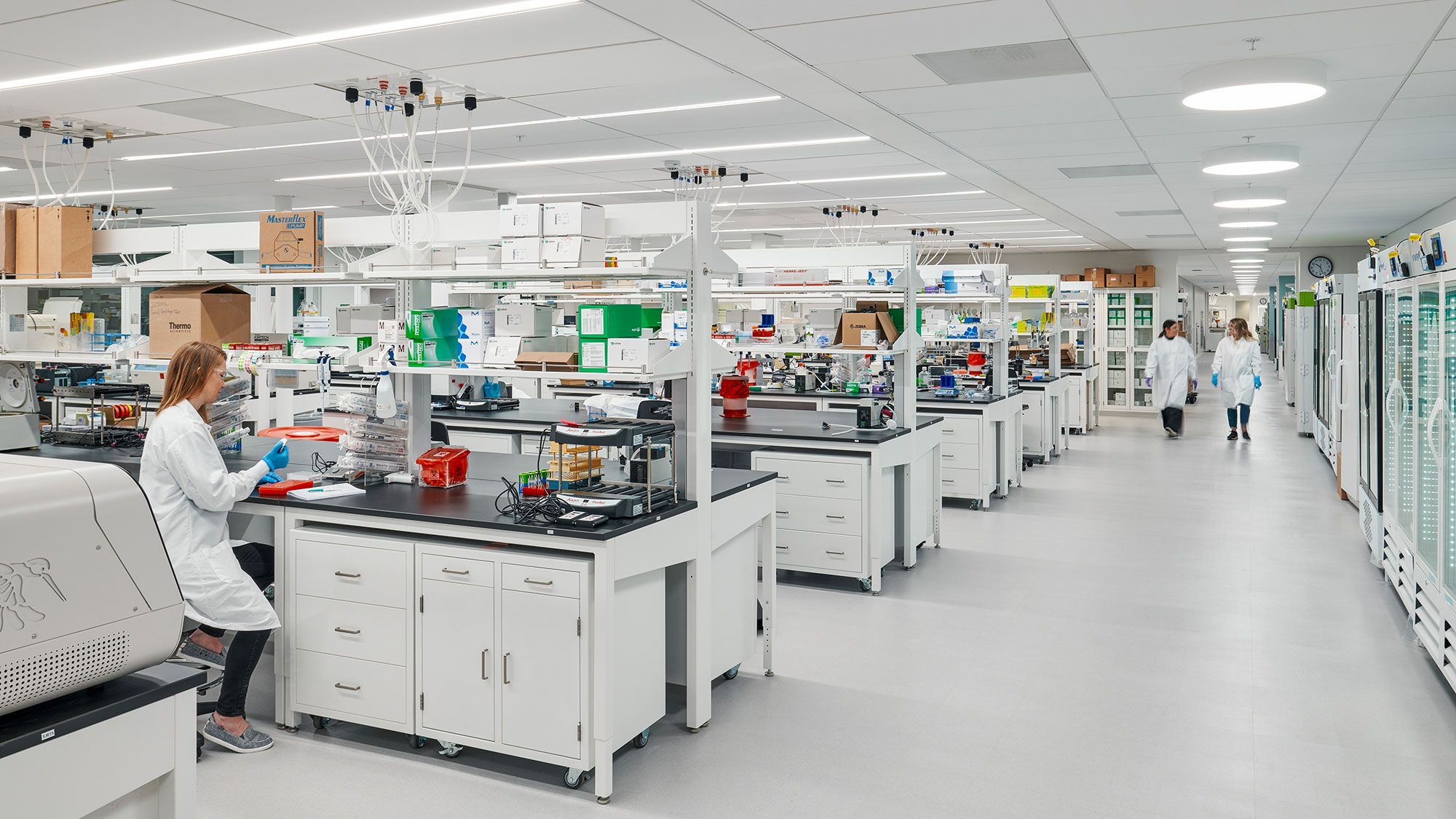
As companies make substantial investments in their lab spaces and real estate, it’s more important than ever to consider how cutting-edge AI innovations will influence the design and operations of future laboratories. With technology evolving at an unprecedented pace, the world of research and development is being reshaped, driving profound changes across a variety of scientific fields.
Here, we explore how emerging technologies — particularly artificial intelligence, automation, and machine learning — are revolutionizing scientific research. These advancements are not only transforming how scientists work but also redefining collaboration and the partnerships that fuel innovation in the lab.
As technology continues to evolve according to the principles of becoming smaller, faster, and cheaper, and as the law of accelerating returns drives further innovation, the work done in the lab stands on the verge of a significant transformation.
Our insights allow us to envision and conceptualize future lab typologies and anticipate a variety of futures. These near and next-generation typologies will increasingly dominate the industry in the coming years.
Our research has taught us three principles of how technology drives change:
1. The nature of technological change is that technology becomes smaller, faster, and cheaper over time.
2. This change makes technology both more powerful and more accessible, accelerating disruptive innovation — this is the “law of accelerating returns.”
3. Dematerialization has been a key characteristic of disruptive innovation over the last 30 years and is expected to continue with the advancement of AI.
Gensler's 2024 Future of Labs Report.
Here’s a more detailed look at these future lab typologies:
The Modular Lab: NOW
Modular labs have revolutionized laboratory design by offering flexibility and modularity with movable components, distributed services, and easy connections for rapid layout changes. They seamlessly integrate into space planning across “writeup space” (dedicated areas for scientists to carry out research/experiments and write-up their work) and previous office configurations, encouraging collaboration and accommodating diverse teamwork needs with their adaptable designs and vibrant settings. Modular labs can seamlessly integrate into space planning across the lab and office space, encouraging collaboration and accommodating diverse teamwork needs with their adaptable designs and vibrant settings.
The benefits of modular labs include reduced need for extensive renovations due to their easy reconfiguration, enhanced productivity through operational adaptability, and environmental advantages from minimizing waste associated with traditional remodeling and construction. These labs meet the evolving demands of the life sciences field by providing versatile and adjustable environments.
The Outsourced Lab: NOW & NEAR
In today’s fast-changing scientific research landscape, organizations are under increasing pressure to innovate while managing costs and resources efficiently. Outsourcing laboratory functions is playing a growing role in driving scientific innovation. It offers valuable advantages to many organizations, especially smaller companies and startups. By using outsourced labs and CRO partners, these businesses can tap into advanced expertise and cutting-edge technologies that may be too expensive or difficult to maintain in-house. This access significantly enhances the quality of research and speeds up the pace of innovation.
Access to cutting-edge research capabilities also democratizes high-level research and fosters an inclusive scientific community where diverse perspectives and ideas contribute to scientific progress. Additionally, outsourcing lab functions can promote environmentally sustainable practices through resource optimization, reduced duplication, advanced technology adoption, shared facilities, efficient waste management, and integration of eco-friendly practices into operations. This approach aligns with environmental stewardship and can help organizations achieve their sustainability objectives while advancing scientific research.
Outsourcing laboratory functions offers a strategic advantage for organizations seeking to enhance their research capabilities, optimize resources, and foster a collaborative and sustainable work environment. By leveraging external expertise and technologies, companies can drive innovation and scientific progress while achieving significant cost savings and operational efficiencies. As the field of outsourced labs continues to evolve, embracing emerging trends and developments will be crucial for maximizing the benefits and ensuring long-term success.
The Virtual Lab: NOW, NEAR, and NEXT
Virtual labs and digital environments that merge fields like biology and chemistry with advanced technology are revolutionizing research and development by combining computational models with AI-driven insights.
In virtual labs, traditional laboratory equipment is being replaced by digital counterparts. Biological compounds are precisely modeled down to the subatomic level. Quantum computers, machine learning algorithms, and artificial intelligence collaborate to process extensive data and simulate complex biological systems. This setup enables researchers to accurately model molecules, proteins, and biochemical interactions, perform simulations, predict outcomes, and design experiments without needing physical lab space.
Quantum computing plays a pivotal role in this transformation. Its ability to conduct simulations, analyze data, and optimize processes surpasses the capabilities of traditional computers. This technology enhances our capability to model complex systems, accelerates scientific discoveries, and addresses challenging problems in science and engineering. Despite the existing technical challenges, quantum computing has immense potential. It promises to expand the boundaries of scientific exploration and enhance research capabilities.
AI and machine learning are essential to this shift. These advancements automate routine tasks and enable in-depth data analysis, allowing scientists to concentrate on more strategic and innovative aspects of their work. Virtual labs use digital replicas of tools to reduce the need for physical space and materials. This shift enhances flexibility and precision in experimental design, leading to significant cost savings, faster research, and a reduced footprint.
Furthermore, virtual labs enable the creation of detailed simulations of biological systems without relying on live animals. This approach offers insights into disease mechanisms, drug interactions, and genetic factors, reducing the need for animal testing and supporting ethical research practices over time.
As virtual labs become more common, they significantly impact office environments and research workflows. By transitioning many research activities to digital spaces, virtual labs allow more space for new partners and teammates in office designs. There are opportunities for more collaboration spaces and project spaces that facilitate real-time collaboration across locations and support multidisciplinary teamwork, fostering innovation.
Looking ahead, virtual labs hold great promise for advancing precision, providing immersive research experiences, enabling dynamic experimentation, and democratizing access to high-level science. By leveraging computational models, AI, digital technologies, and, in the future, quantum computing, virtual labs will make research more efficient, collaborative, and sustainable, driving progress across a variety of scientific disciplines.
What will the future of your lab look like? At Gensler, we’re hosting a series of roundtable discussions to explore this transformative topic, and we’d love for you to be part of the conversation. This ongoing series offers a unique opportunity to engage with thought leaders, share insights, and discover how AI and innovation are reshaping the lab environment.
If you’re interested in joining one of these discussions, we’d be excited to hear from you. In the meantime, download the full white paper to dive deeper into the trends and strategies driving the future of labs.
Additional contributors to this white paper include: Joel Fariss and Leah Bauer, with special thanks to Zach Serber, Betsy Bayha, Zack McGahey, and Brian Stonerock.
For media inquiries, email .



